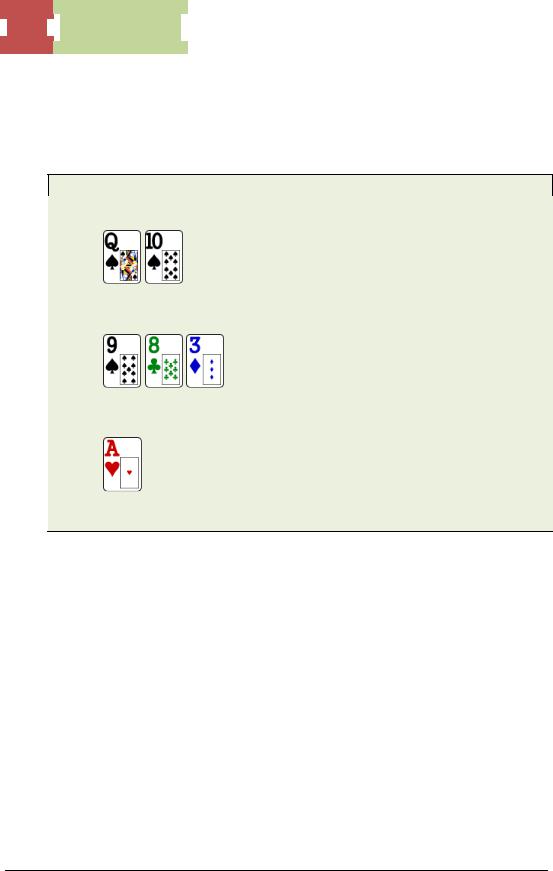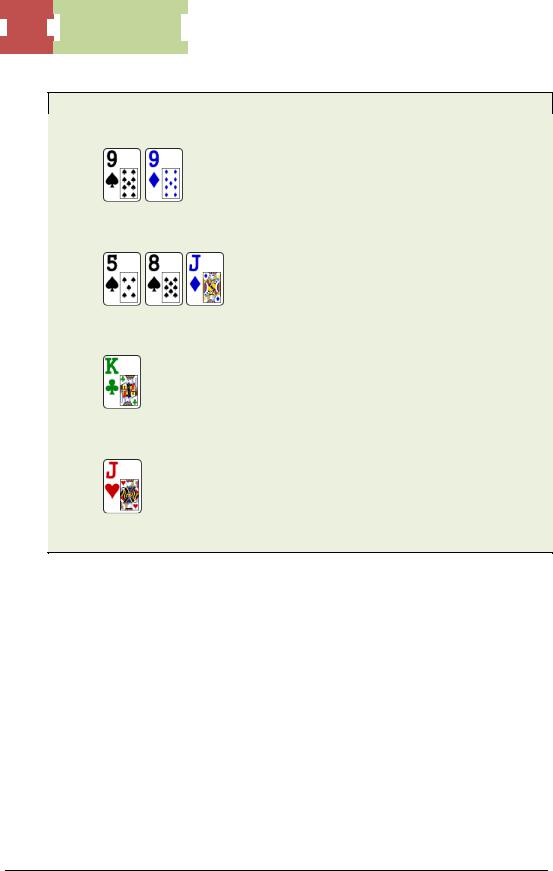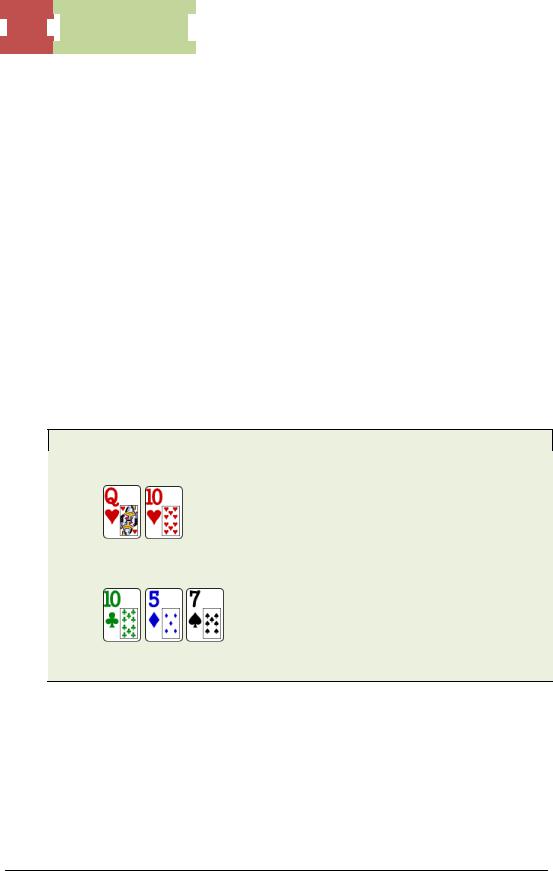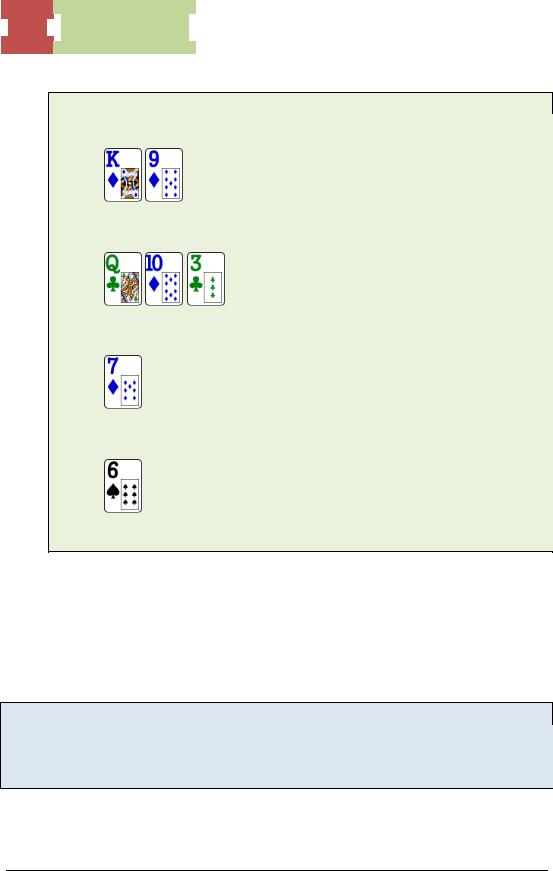
Davis, Aron. The Poker Blueprint
.pdf
 159
159  Scare Cards
Scare Cards
A scare card weakens your perceived range while it strengthens your opponent’s perceived range. An overcard such as an Ace or a king is usually used in pots as a scare card. Here is a simple example.
100 NL – 6 max. 100BB effective stacks. MP raises to $4. You call on the BTN with
The blinds fold. The flop is
Villain checks and you check. The turn is an
Villain bets $7. What is your play?
Usually in this situation, if I don’t have a hand with showdown value, I will raise the turn.
This is because Villain would bet at the turn Ace almost always. However, the strongest hand in his range is AK, and even that is a little optimistic since he usually bets the flop with that hand. He can’t have two pair because he would’ve bet the flop with A3, A8, and A9. He might show up with a set, but that rarely happens because players almost always c-bet to build the pot when they flop a set. So, his turn range is usually an Ace with a weak kicker or some random hand. How do we counter his bet? As always, the answer depends on the type of opponent you are dealing with.
If I’m facing a fishy player, then I will make a 3x raise on the turn and give up if he calls. Fishy players don’t like to fold Ax. When I’m raising the turn, it’s to fold all his random hands. One can make an argument for calling the turn and betting the river if it is checked to you. However, what if the fishy player doesn’t check to you on the river and bets again? He may be value-betting with an ace or bluffing. We don’t know. For this reason, I like to make a turn raise and give up.
© 2010 Aaron Davis and Tri Nguyen - All Rights Reserved.
http://www.DailyVariance.com
159

 160
160  Scare Cards
Scare Cards
If I’m playing against a regular player, then I will raise this turn almost always and follow through with a river bet. A decent player will realize that my range contains a lot of strong hands. It’s normal for anyone to check back the flop with a set, A9s, A8s, and A3s. If you bluff the river and get called, then take a note that he likes to call with a marginal hand when he realizes it’s the top of his range. Either that or he doesn’t like folding top pair.
What usually happens is that the table regular folds to the turn raise or calls and folds to a big river bet. You must remember to follow through with your river bet. If you don’t intend to bet the river, then it’s best to fold to his turn bet and save yourself some money.
Regarding the above situation, I will give up on the hand if the board pairs. All your value hands are less likely now and players will have trouble folding a pair of aces on a paired board.
Let’s look at a more complex example.
© 2010 Aaron Davis and Tri Nguyen - All Rights Reserved.
http://www.DailyVariance.com
160

 161
161  Scare Cards
Scare Cards
100 NL – 6 max. 100BB effective stacks. MP opens for $4. You call in the CO with
The flop is
Villain bets $8 into $9.50. You call. The turn is a
He bets $21 into $25.50 and you call. The river is a
He shoves $67 into $67.50. What is your play?
Before getting to our decision, let’s analyze the hand, street by street. Pre-flop is normal. On the flop, there are a lot of high-card hands and semi-bluffs that Villain can have in his range so we call. The turn is an interesting card because he can easily have a pair of kings (AK, KQ, KTs). He can also have sets, two pairs (KJ), one pair such as QJs, AJ or AA. However, he will also have a lot of flush draws and straight draws (T9s, QTs, ATs, AQ). Combination-wise, that’s 12 combos of AK, 12 combos of KQ, 3 combos of KTs, 12 combos of sets, 9 combos of KJ, 3 combos of QJs, 12 combos of AJ and 6 combos of AA. That’s 66 combos of value hands that he’s betting on the turn.
For semi-bluffing hands, he has 2 combos of T9s, 4 combos of QTs, 4 combos of ATs, 16 combos of AQ, 4 combos of 76s, 2 combos of 79s and about 10 combos of Ax of spades. That’s roughly 42 combos of semi-bluffing hands, plus a few random hands that he may bluff the turn with since it’s such a great card for his range and such a bad card for our range. Let’s give him ten of these random hands. We beat about 52 of Villain’s hands on
© 2010 Aaron Davis and Tri Nguyen - All Rights Reserved.
http://www.DailyVariance.com
161

 162
162  Scare Cards
Scare Cards
the turn, so we should fold the turn. But since we made a bad turn call, we get to the river.
The river is an interesting card because it polarizes his betting range. You have a few Jx in your range that he has to be afraid of. This means that he’s going to shove the river for value with hands such as QJs (2 combos), AJ (8 combos), 55 (3 combos), 88 (3 combos), KK
(3 combos), JJ (one combo). That’s a total of 20 hands on the river. Sometimes he will value-shove with hands such as AK and AA, but he is more likely to check-call with those holdings, so the times they bet will negate the times they check, so we don’t have to account for them in our calculation. What about his drawing hands?
Now let’s assume that he gets to the river with the 52 hands that we assigned him on the turn. If he bluffs with half of them, it is an easy call because we will win half of the time while getting 2-to-1 odds. But since microand small-stakes players don’t bluff that often in this spot, we have to adjust Villain’s bluffing frequency. In reality, bluffing frequency in this spot is about 20 to 25 percent in low-stakes games. Nevertheless, if Villain is an aggressive opponent who follows through with his bluff sometimes, you should call. If Villain is a nit, fold. A nit will show up with the rare nut hands in this spot all the time.
What is the main reason for showing you this hand? It is to show you the hand analysis that I go through away from the table to improve my game. It is also to show you that when a turn scare card comes, it increases Villain’s bluffing frequency dramatically. More importantly, it is to show you that if an opponent represents a strong hand on the turn but the river improves your perceived range and narrows his value-betting range a lot, you should call a big river bet. Unless, of course, you are dealing with a 9+ tabling nit who will check the river if he doesn’t have trips or better because he is afraid you have Jx.
© 2010 Aaron Davis and Tri Nguyen - All Rights Reserved.
http://www.DailyVariance.com
162

 163
163  Timing Tells
Timing Tells
Timing Tells
© 2010 Aaron Davis and Tri Nguyen - All Rights Reserved.
http://www.DailyVariance.com
163

 164
164  Timing Tells
Timing Tells
There are some great players who think timing tells are overrated; others players swear by it. I believe they exist, and sometimes I use them to make a big bluff or to check back the river with a strong hand. The main reason for its existence is that everyone’s playing style has a pattern. Sometimes we auto-pilot and we don’t know we’re auto-piloting. Other times, we unwillingly let our emotions take over. I know I’ve called too quickly a few times in my playing career because I was acting on adrenaline. Let’s go through a few scenarios.
Quick Call
From my experience after hundreds of thousands of hands, a quick call is usually an attempt to appear strong and to slow down the aggressor on the next street. With a strong hand, a player would take more time thinking about his option (whether to donk bet, check-raise, or check-call). In some situations, we have no option besides checkcalling, so we often act way too fast.
For example:
100 NL – 6 max. 100BB effective stacks.
The BTN raises to $6 and we call from the SB with
The flop is
We check to Villain and he makes a standard $10 c-bet. We insta-call.
We have been through this situation many times. Unless there is some crazy history, we know the best play. Thus, we don’t take too long to check-call. However, let’s say we have
J9 of clubs in the same situation. Now our flop action is a little delayed. We need more time to think about whether to check-call, check-raise or check-fold.
Of course, there are players out there who check-call quickly with the nuts to feign weakness, but this number is exceedingly small. In fact, you wouldn’t lose much if you paid no heed to a fast check-call. Consider that the percentage of players who check-call
© 2010 Aaron Davis and Tri Nguyen - All Rights Reserved.
http://www.DailyVariance.com
164

 165
165  Timing Tells
Timing Tells
fast with a weak hand is way higher than those who do so with a monster hand, and that the benefits of winning a lot of dead money outweighs the times you get clipped off by a monster.
A reliable tell that I have used many times is when a fish check-calls really fast on boards where flush draws are possible. He doesn’t care about correct pot odds; he likes to draw no matter what. Against players like him, I usually bet half-pot on the river to get them to fold their missed draws. There’s no need to bluff with a bigger bet size because they aren’t going to fold a made hand. Your goal is to make them fold a draw that has a high card that might beat you.
Slow Call
By “slow call”, I’m not talking about a few seconds of delay. I’m talking about tanking, tanking, then calling. Unless your opponent has a history of taking his time during hands, he almost always has a strong hand and wants you to bluff off your chips. Regular grinders aren’t morons. They know when they are taking time with their hands. The majority of the time, it’s calculated.
Of course, some players genuinely take their time to call because they are facing a difficult decision and don’t know the best course of action to take. Regarding these players, your guess is as good as mine since I need to play against them to know. As a default, I would start off by bluffing the river and see how they react to it. Some players fold all the time. Some call a lot. This is one of those concepts you have to try out for yourself to know which players belong to which categories.
Let’s look at an example to illustrate this concept.
© 2010 Aaron Davis and Tri Nguyen - All Rights Reserved.
http://www.DailyVariance.com
165

 166
166  Timing Tells
Timing Tells
100 NL – 6 max. 100BB effective stacks.
You raise $6 from the BTN with
The SB calls and the flop is
He checks, you bet $11 and he calls. The turn is a
He checks. You bet $22. He tanks for a while and finally calls. The river is a
What should you do?
On such a draw-heavy board, once he check-calls the turn, the strongest hand that he can show up with is QJ. Any better hand probably check-shoves the turn to avoid playing the river. So, when he tanks on his turn decision, he is usually figuring out whether he is getting the odds to call a turn bet. On this board texture, if he is tanking, he is usually holding a pair with a flush draw or flush plus straight draw. On the river, I would shove the majority of the time if I couldn’t beat Qx. I would expect to take down the pot often.
Important Note: If you are the type of player who will bet this turn but won’t follow through on the river, you should check the turn the majority of the time. Because the board is so drawy by the turn that once Villain check-calls, the river is almost a mandatory shove.
© 2010 Aaron Davis and Tri Nguyen - All Rights Reserved.
http://www.DailyVariance.com
166

 167
167  Glossary
Glossary
Glossary
© 2010 Aaron Davis and Tri Nguyen - All Rights Reserved.
http://www.DailyVariance.com
167

 168
168  Glossary
Glossary
1.Unless specified, all examples are from
a.100NL (for the sake of consistency and simplicity).
b.6-max games with 100BB.
i. With 2 players in a pot
2.Unless specified, all c-bets are 3/4-pot.
3.Positions
a.SB = small blind
b.BB = Big Blind
c.UTG = Under the Gun
d.MP = Middle Position
e.CO = Cutoff
f.BTN = Button
4.Check-call means you check and then call a bet
5.Bet-Fold means you bet and then fold to a raise
6.Call/Fold/Raise means you should call, fold, or raise
7.Isolate – raising or re-raising someone (usually a weaker player) to play head up against
8.SCs – suited connectors
9.Ax, Kx, Qx etc… - “x” is any random card that does not pair the first card
10.JTs, 86s etc… – JT suited, 86 suited
11.C-bet - continuation bet
12.TPTK – top pair top kicker
13.TPGK – top pair good kicker
14.TPWK – top pair weak kicker
The 4 color deck used in this book can be found at TiltBuster.com. They have many more designs at their site. These cards are great because they are easy on the eyes and can be a great help when logging long sessions. Most can be purchased for about $10 and are easy to install.
© 2010 Aaron Davis and Tri Nguyen - All Rights Reserved.
http://www.DailyVariance.com
168
